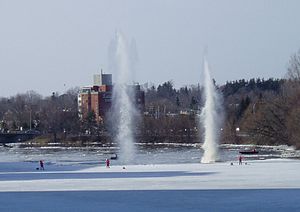| Revision as of 04:40, 17 January 2017 editAlaney2k (talk | contribs)Autopatrolled, Extended confirmed users, Pending changes reviewers246,660 editsm →top: updated city to include province using AWB← Previous edit | Revision as of 03:26, 15 March 2018 edit undoAlaney2k (talk | contribs)Autopatrolled, Extended confirmed users, Pending changes reviewers246,660 editsm →top: format placenames per wp:canplace using AWBNext edit → | ||
| Line 3: | Line 3: | ||
| This is done during the spring when snow is melting and river ice is breaking up. There is always a chance that the ice flows could collide creating an ] and blocking the river. The river, filled with melt water, will quickly ] and often cause damage to nearby settlements. Thus in most northern areas governments quickly act to break up the ice jams before they can do much damage. This is most easily done with explosives. These explosives may be planted from the shore, or in some cases by helicopter. Explosives can also be remotely delivered by artillery or dropped by bombers. In the large rivers of the ] the Russian airforce is sometimes called in to bomb ice jams. | This is done during the spring when snow is melting and river ice is breaking up. There is always a chance that the ice flows could collide creating an ] and blocking the river. The river, filled with melt water, will quickly ] and often cause damage to nearby settlements. Thus in most northern areas governments quickly act to break up the ice jams before they can do much damage. This is most easily done with explosives. These explosives may be planted from the shore, or in some cases by helicopter. Explosives can also be remotely delivered by artillery or dropped by bombers. In the large rivers of the ] the Russian airforce is sometimes called in to bomb ice jams. | ||
| Some districts, where flooding is especially common, do preemptive ice blasting. The city of ], |
Some districts, where flooding is especially common, do preemptive ice blasting. The city of ], Canada, for instance, blasts the ] each spring to break up the ice. In 1994, for instance, 10,000 sticks of dynamite were used to break up ice along 9 kilometres of the river.<ref> | ||
| Grant Hopkins "Ice-blasting on Rideau will have to be limited to avoid heavy fish toll, study says." ''The Ottawa Citizen.'' Jun 12, 1994. pg. D.6</ref> | Grant Hopkins "Ice-blasting on Rideau will have to be limited to avoid heavy fish toll, study says." ''The Ottawa Citizen.'' Jun 12, 1994. pg. D.6</ref> | ||
Revision as of 03:26, 15 March 2018

Ice blasting is the use of explosives to break up ice in rivers, greatly aiding navigation systems. This is done during the spring when snow is melting and river ice is breaking up. There is always a chance that the ice flows could collide creating an ice jam and blocking the river. The river, filled with melt water, will quickly flood and often cause damage to nearby settlements. Thus in most northern areas governments quickly act to break up the ice jams before they can do much damage. This is most easily done with explosives. These explosives may be planted from the shore, or in some cases by helicopter. Explosives can also be remotely delivered by artillery or dropped by bombers. In the large rivers of the Siberia the Russian airforce is sometimes called in to bomb ice jams.
Some districts, where flooding is especially common, do preemptive ice blasting. The city of Ottawa, Ontario, Canada, for instance, blasts the Rideau River each spring to break up the ice. In 1994, for instance, 10,000 sticks of dynamite were used to break up ice along 9 kilometres of the river.
Ice blasting has a number of disadvantages. It is expensive and dangerous requiring highly skilled explosives experts. When blasting is occurring the public must be warned to keep their distance. The blasting has negative environmental consequences. Fish and other river creatures are inevitably killed and the river bottom is scarred. Unexploded ordnance can also be a concern where remote delivery is used.
References
- Grant Hopkins "Ice-blasting on Rideau will have to be limited to avoid heavy fish toll, study says." The Ottawa Citizen. Jun 12, 1994. pg. D.6
- Tom Spears. "Halt ice blasting on Rideau River, Ottawa urged." The Ottawa Citizen. Apr 5, 1995. pg. B.4